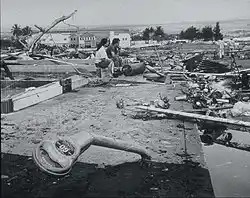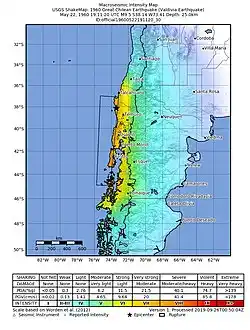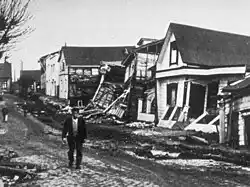
The 1960 Valdivia earthquake was an earthquake that struck the Valdivia region of southern Chile on the 22nd of May 1960. At a magnitude of approximately 9.5 it was and remains the most powerful earthquake ever recorded. It lasted for ten minutes and created a tsunami out at sea which spread around the South Pacific Ocean. While most of the impact of the earthquake and tsunami were felt in Chile and neighboring Argentina, the tsunami impacted on countries and regions as far away as New Zealand, Japan, China, the Philippines, Australia and Hawaii, while Easter Island, Samoa and other Polynesian islands were also struck. The number of deaths is estimated to have been anywhere between 1,000 and 6,000 people. Hundreds of thousands of homes were destroyed near the epicenter in southern Chile and millions of people were temporarily displaced in an event which is also known as the Great Chile Earthquake.[1]
Research your ancestors on MyHeritage
1960 Valdivia earthquake chronology of events1960 Valdivia earthquake chronology of events
Chile is one of the great centers of tectonic activity in the world. The Chile Triple Junction is found here. This is the name given to the conjunction of three of the world’s larger tectonic plates, the South American Plate, the Nazca Plate and the Antarctic Plate. Consequently, there have been many large earthquakes recorded here since the sixteenth century. For instance, in the space of just half a decade two major earthquakes and accompanying tsunamis struck south Chile in 1570 and 1575, killing thousands. The latter of these was centered on Valdivia.[2] The 1868 Arica earthquake eclipsed these, measuring a magnitude of between 8.5 and 9.2. The quake and the resulting tsunami are believed to have killed over 25,000 people in Chile and Peru, though official records were sparse at this time.[3] More recently, a powerful earthquake struck near Maule in Chile in 2010. Thus, there is a long history of major earthquakes in Chile, ones which nearly always cause tsunamis as well in this elongated coastal country.[4]

The Valdivia earthquake of 1960 was preceded by four major foreshocks, the largest of which was a magnitude of 8.2 that occurred on the 21st of May 1960 and caused considerable damage around Concepción in Chile. The following day the main earthquake occurred. It measured roughly a magnitude of 9.5, though some studies place it marginally lower or higher at 9.4 or 9.6. This makes it the most violent earthquake in recorded history.[5] However, was the case with many such natural disasters like the 1755 Lisbon earthquake and tsunami and the 2004 Indian Ocean earthquake and tsunami, most of the death and destruction from the 1960 Valdivia earthquake was the result of the tsunami it created. This caused immense damage along Chile’s long coast and then spread out all around the South Pacific Ocean. Eventually waves would reach the many islands of the Pacific and as far afield as New Zealand, Australia, the Philippines, China, Japan and Hawaii. Moreover, aftershocks continued to occur for five months after the main earthquake, some measuring as high as a magnitude of 7 up to the end of October 1960.[6]
The rupture zone in Chile itself was 1,000 kilometers from Puerto Aysen to Lebu. The number of fatalities stretched into the thousands, but owing to a lack of adequate record-keeping at the time it is unclear if it lay closer to 1,000 or 6,000. Moreover, there were hundreds of thousands of homes destroyed and two million people were left homeless. The damage would eventually cost over half a billion dollars in 1960s’ money.[7] There were 61 deaths in Hawaii, as well as several deaths on the West Coast of the United States and in Mexico. It took a day for the tsunami to hit the coast of Japan. When it did it killed 139 people and destroyed thousands of homes. Nearly two dozen people died in the Philippines. The damage was sufficient that the International Tsunami Warning System of the Pacific was established in the aftermath of the earthquake and tsunami. The damage and death, though considerable, was ultimately dwarfed by that which followed from the 2004 Indian Ocean earthquake and tsunami, despite the 1960 earthquake being without peer in terms of its strength.[8]
Demographic impact of the earthquake and tsunamiDemographic impact of the earthquake and tsunami

The demographic impact of the earthquake and tsunami was primarily felt in southern and Chile. The earthquake was so violent that it effectively stretched Chile outwards, adding several square kilometers to the size of the country. This wasn’t without negative consequences and several major towns and villages near the epicenter of the quake were devastated. Towns like Valdivia experienced a marked population decline in the aftermath of the disaster, while major cities like Santiago welcomed a large number of refugees from the south. This demographic impact was broadly transient though. Over time the towns and villages were rebuilt and people returned home. Valdivia has re-emerged as a city of over 140,000 people today. Nevertheless, some people throughout Chile will have a grandparent or parent who relocated to another part of Chile or moved abroad entirely in the 1960s as a result of the dislocation caused by the 1960 Valdivia earthquake and tsunami.[9]
See alsoSee also
Explore more about the 1960 Valdivia earthquakeExplore more about the 1960 Valdivia earthquake
- Chile, Civil Registration records collection on MyHeritage
- Chile, Baptisms, 1585-1932 records collection on MyHeritage
- Chile, Marriages, 1579-1930 records collection on MyHeritage
- Chile, Santiago Burials records collection on MyHeritage
References
- ↑ https://www.ngdc.noaa.gov/hazard/22may1960.html
- ↑ https://www.researchgate.net/figure/Graphical-summary-of-the-compiled-evidence-for-the-1575-1960-earthquake-sequences-along_fig1_320915518
- ↑ https://www.usni.org/magazines/proceedings/1926/july/tidal-wave-and-earthquake-arica-peru-1868
- ↑ https://earthobservatory.nasa.gov/images/43123/strong-aftershocks-rattle-chile-following-big-quake
- ↑ https://www.npr.org/2016/08/29/490239181/when-the-biggest-earthquake-ever-recorded-hit-chile-it-rocked-the-world
- ↑ https://www.cbsnews.com/news/hawaiis-1960-tsunami/
- ↑ https://education.nationalgeographic.org/resource/valdivia-earthquake-strikes-chile/
- ↑ C. Martin Duke, ‘The Chilean Earthquakes of May 1960’, in Science, New Series, Vol. 132, No. 3442 (Dec. 16, 1960), pp. 1797–1802.
- ↑ William E. Rudolph, ‘Catastrophe in Chile’, in Geographical Review, Vol. 50, No. 4 (October, 1960), pp. 578–581.

